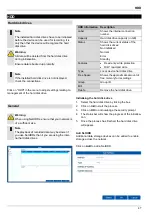
Maintenance
60
(‘pinging’). Enter the network address of the device to be
checked (e.g. 192.168.0.25) and click on
Test
.
Information on two parameters will appear:
Parameter
Setting
Average
delay
The time the pinged device needs to
reply.
Packet loss
rate:
Displays the percentage of packets
that were not transmitted.
Note
If the packet loss rate is high, we recommend that
the "Network Delay, Packet Loss Test" is re-
peated.
Note
If the packet loss rate is still high, you should
check that the network cables are correct and not
damaged.
The higher the packet loss rate, the poorer the
connection between the pinged device and the re-
corder.
Under "Network Packet Export", you can export the set-
tings of the individual connections or, depending on the
setting,
the connection.
1. For "Device Name", select a storage medium to save
the settings to.
2. Click on
Export
.
After the progress display finishes and initialisation is
successful, an information window will appear. Close
it by clicking on
OK
.
Click on Status to display the status of the LAN con-
nections (connected/not connected).
Click on
Net Detect
to change your network settings.
Network Stat. tab
The bandwidth used by the device is displayed under this
tab.
You can refresh the data by clicking on
Refresh
.
HDD Detect
Click on the "HDD Detect" submenu.
This submenu gives you the option to check your hard
disk drive for errors.
HDD
Selection of the hard disk drive to
be processed
Self-test Status
Shows the status of the current self-
test.
Self-test Type
Select the type of self-test
Short Test/Expanded Test/Convey-
ance Test
S.M.A.R.T
Click on the icon to start the self-
test
Temperature (°C) Shows the hard disk drive tempera-
ture
Power On
(days)
Shows the operating days of the
hard disk drive
Self-evaluation
Shows the status of the self-evalua-
tion
Complete evalua-
tion
Shows the status of the evaluation





















